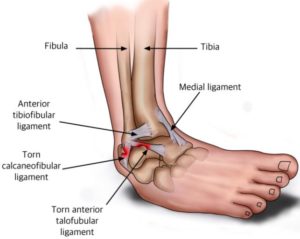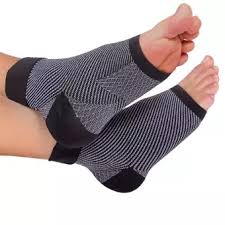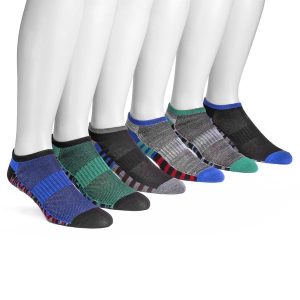Does your profession make you stand on your feet for an extended time? Or you are an athlete that regularly twists, turns and suddenly stops when in motion? Whatever the reason, if you engage in activities that place pressure on your ankle joints, then you should seriously consider getting help to prevent injury to this rather injury-prone area of your body.
Using special socks for ankle support daily helps to protect and safeguard vulnerable ankles and the muscles/tendons around them.
Let’s take a look at why ankles are vulnerable and what you can do specifically to keep yours in tip-top shape:
Understanding Ankle Sprains
Ankle sprains are certainly a frustrating condition as they can cause serious pain as well as immobilization. It can take more than 120 days to recover fully from an ankle sprain (often longer than a break!), depending on the severity and the complexities of the situation. An ankle sprain occurs when ligaments tear in the ankle from forceful, sudden twisting or bending. The outer part of the ankle is the region where most ankle sprains happen and this one of the more frequent injuries that affects people today.

In the ankle, several ligaments link bones together and tendons also connect muscle to bone. Among these are many commonly sprained ligaments. Two of these are the anterior talofibular ligament (ATFL) and the calcaneal fibular ligament (CFL). The anterior talofibular ligament connects the talus to the fibula on the outer part of the ankle, while the calcaneal fibular ligament connects the fibula to the calcaneus.
Pain from ankle sprains is usually a sign of an inversion injury, which means that the foot was forced to roll or bend beneath the leg or ankle where it clearly is not meant to go. Bruising or swelling will generally happen shortly after the sprain and a person with a sprain might be unable to place weight on their feet almost immediately.

Athletes have the highest risk of obtaining an ankle sprain injury, for obvious reasons. Activities that can put people at risk include involvement in activities like soccer, basketball, football, volleyball, running and tennis. In these forms of exercise, there are quick movements, abrupt change in direction and jumping–all of which are critical for success in the sporting activities but put a person at risk of injury.
Almost 50% of all athletic-linked injuries are the aftermath of a sprained ankle, and 80% of these sprained ankles are inversion injuries. If the ligament is badly torn, it can take more than six weeks to heal, which is upsetting to many athletes who are in competition or training. Certain people with weak muscles and “hindfoot varus” are predisposed to ankle sprains and must take extra care when performing any activity that involves legwork. Hindfoot varus is a medical condition of deformity in the alignment of the heel and ankle, causing it to come down at an angle instead of straight down.

Individuals who have experienced severe ankle injuries in the past should be careful to avoid injury and sustaining further damage. The good news is that since sprains are the most frequent occurrences in injuries, they can be quickly diagnosed. Symptoms and signs of an ankle sprain may include pain, tenderness, and/or swelling stemming up from the outer part of the ankle directing to an inversion injury. This typically means that the bone is not broken.
The vast majority of ankle sprain cases do not require surgery because ligaments are capable of repairing themselves without intervention. At this point, the use of ankle support socks, braces, and sleeves come handy.
Compression Socks for Swollen Ankles and Injury Protection
Compression is one of the key ways to control swelling. Wearing ankle support socks not only provides support but also increases blood circulation, which aids in a quick recovery. The continuous and consistent pressure provided by ankle support socks may assist the veins in pushing deoxygenated blood to the heart to enhance the flow of the oxygen-rich blood to the working muscles and, ultimately, promoting healing.
Additionally, compression socks give physical support to damaged tissues that surround the ankle, including the ligaments. Ankle support socks may also help in alleviating the pain as it lessens the exertion of weight on the injured foot.
Don’t think that ankle support socks should only be worn during injury, though. Medical professionals advise that these therapeutic devices could be worn when a person is engaging in a task that places pressure on the foot. Especially those with a history of ankle injury should wear ankle support socks before engaging in physical activities to prevent further injury. In fact, nurses are commonly found wearing compression socks during long hospital shifts.
Some of the fundamental features of ankle support socks are to prevent re-injury and injury. Apart from avoiding ankle sprain and enhancing recovery time, ankle support socks have four distinct benefits to users who wear them daily.

Ankle support socks may assist in improving balance and performance during physical activities. Since the compression sleeves applied around the leg helps to enhance blood flow to the muscles, it may lead to a higher rate of oxygen supplied to the muscles, which can generate additional energy.
The soothing comfort that the ankle support socks provide is particularly useful during an injury but also for prevention purposes. Compression ankle socks can protect the ankle from further injury since they stabilize the foot to reduce the impact of external forces.
Choosing Ankle Support/Compression Socks
Several brands of ankle support socks are available on the market today. They vary in color, shape, and overall design. Your doctor may have recommendations related to the style, size and amount of compression needed for your specific needs, whether preventative or recovering from injury.
Below are some of the most important factors to consider as you determine which Ankle Support Stockings you need.
Factors to Consider Before Purchasing Ankle Support Socks

1. Breathability
The fabric your compression socks are made of will have an impact on the way that they function. Since you’ll likely be wearing them during activity, breathability is a must-have feature of ankle support socks. They should be stretchy, to provide your ankles with support, and should be knitted in a way that does not keep the heat inside but can “breathe”.
Some brands of ankle support socks are also toeless, which some people prefer because it keeps their feet cooler and feeling less restricted in the shoe. The design of toeless support socks allows the feet to remain dry and comfortable.
2. Comfort
Ankle support socks should fit well, without so much restriction that it cuts off the blood flow or causes discomfort. Yes, they should be tight and you’ll feel a slight squeezing, but this shouldn’t be painful. If you’re trying to protect your ankles during sports, your performance certainly won’t benefit from support socks that are uncomfortably tight, or that rub and cause blisters. Buying the right size and pressure is critical in maintaining comfort when you wear compression socks. Many people wear compression socks while sitting at a desk all day. This makes it even more important to focus on comfort.
3. Stability
Support ankle socks should be stable enough to provide support to the ankle in order to reduce the risk of injury or prevent further complications while the ankle heals from an injury. Check with your doctor, pharmacist or another medical professional to give you the details on what the best type of ankle support socks is for your unique situation.
4. Value
Some ‘designer’ ankle support socks might seem better, but don’t get fooled into paying more simply for a brand name. As long as the product you purchase is made from quality materials and constructed well, you don’t need a fancy name attached to it. Lower-priced versions can be worth a try–especially if they provide you with a money-back guarantee that allows you to return them if you are not satisfied.
5. Materials
When selecting a product that can provide compression for your feet, consider the materials that are used in the manufacturing process. Many ankle support and compression socks are made from synthetic materials, such as nylon polyester, blended with a stretchable fabric such as elastane (Spandex).
6. Sizing
In most cases, ankle support socks come in a variety of sizes in order to meet the needs of each individual who will be wearing them. Feet and ankles are different sizes, and support socks need to account for that. Don’t be fooled by a company that offers one-size-fits-all compression socks as they’re simply not going to fit everyone. Legitimate compression sock companies will have you measure the size of your ankle and calf, or at the very least determine what you need based on the size shoe you wear.
Answers to Questions Often Asked About Ankle Support Stockings
Q: Why is it so tight to wear?
Answer: Inherent in their function, the tightness of ankle support socks is exactly the reason that they work. Designed to hug your feet, compression socks are made to do just what the name says, putting pressure on your foot and ankle. At first, you might find them uncomfortable to put on because of their snug fit, but as you become more accustomed to them, you’ll appreciate the tightness for the support and protection it gives you.
Q: Is there a need for me to hand wash the socks?
Answer: In most cases, compression socks need to be washed by hand because they are made of fibers that can be wrung or twisted out of shape when put through the rigorous cycles of a washing machine. Lying your socks flat to dry is also your best bet to avoid the risk of shrinkage in a tumble dryer. That said, following the washing instructions provided by the manufacturer is your best bet.
Q: Can ankle support/compression socks harm my feet?
Answer: Compression socks are a non-invasive medical therapy that should not cause any harm or injury to your feet. The only problem would be if you wore a size that was too small and it compressed so much that it limited the ability for your circulatory system to work properly. This is why wearing the proper size is critical.
Q: How long do compression socks last?
Answer: How long your compression socks last depends on a variety of factors, such as who the manufacturer is and what they are made out of. Other factors might include how often you wear them, what you are wearing them for, and how you care for them. If you wear them regularly, they will likely last for about six months, but if you do not wear them regularly they will last for about one year. Eventually, the elasticity might be compromised and they’ll need to be replaced.
Q: Are compression socks and ankle support socks beneficial?
Answer: According to research, ankle support socks and compression socks are both highly beneficial in many cases but it may depend on who is using them and what they are being used for. Research has proven that compression socks can be particularly beneficial for aiding with swelling in the ankles, varicose veins in the legs and other medical issues. People who wear compression socks for athletic performance have often attested to their effectiveness, although not many studies have been performed to prove this conclusively yet.
Ankle support socks are definitely useful and beneficial for those needing support for the ankle in order to prevent injury as well as for speeding the healing time from an ankle sprain or twist.
If you’ve found yourself in the unfortunate position of an ankle sprain or another injury, or you are at risk for one, then the use of an ankle support sock may be exactly what you need to keep your athletic training on track. If you’re battling with ankle swelling or varicose veins, then compression socks will suit you well.
This page last updated December 16, 2022
